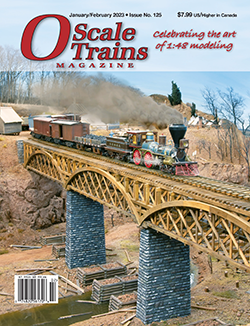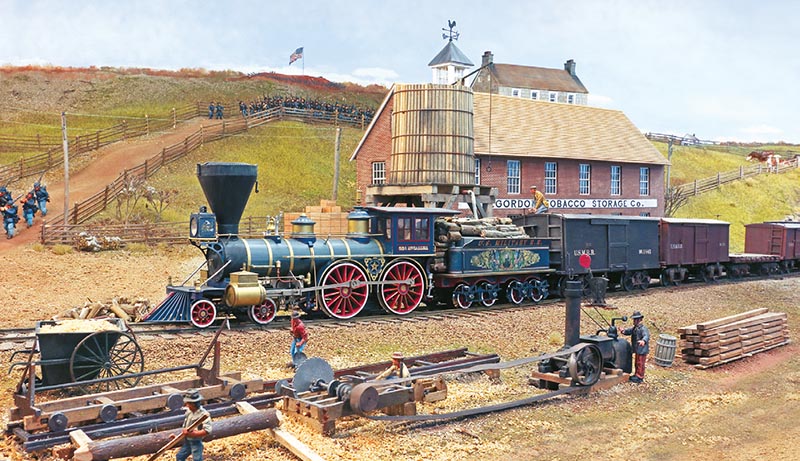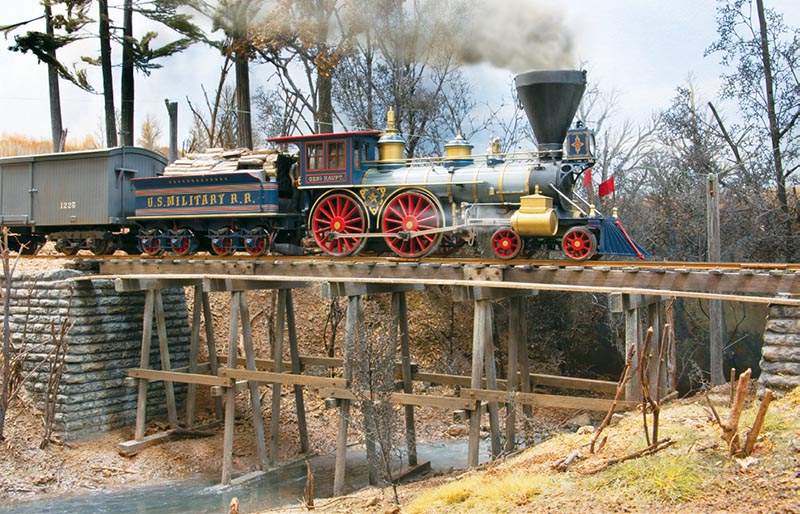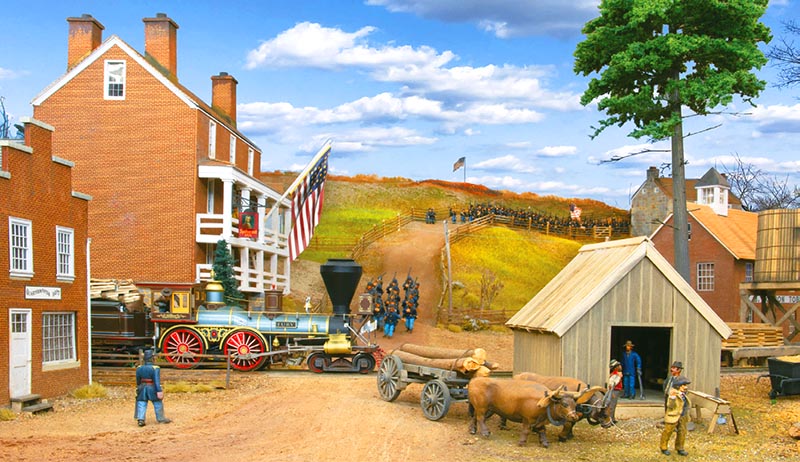 By Bernard Kempinski/photos by the author
By Bernard Kempinski/photos by the author
Since January 2009, I have been building an O scale model rail-road of the United States Military Railroad (USMRR) Aquia Line set during late winter-early spring 1863, during the American Civil War. In this article I will present an overview of my model railroad and describe some of the techniques I am using to model in this interesting period.
Why Model the Civil War?
The first question you might ask is, “Why build a model railroad with a Civil War theme?” As a child growing up in New York City in the 1950s, the Civil War was ancient history, overshadowed by my parents’ experiences in the Great Depression and World War Two. Their stories of those events sparked my interest in military history and modeling, especially armor and dioramas.

ABOVE: Reference sources say that the USMRR had a sawmill on the line, but they didn’t state where it was located. I placed my scratchbuilt sawmill at Brooke where I had a nice flat spot for it.
In the 1980s, I moved to northern Virginia after serving in the U.S. Army. Here, Civil War history surrounds you. The proximity to so many local battlefields, national archives, and other historical sites kindled in me an interest in the Civil War and I became involved in historical research, war gaming, and figure modeling. I became interested in model railroading in the early 1990s due to my young son’s influence and together we built several railroad projects. He lost interest eventually, and I gravitated to the Civil War railroads, especially when Schneider Model Trains started producing wonderful O scale models of Civil War-era engines.
I found the Civil War railroads offered a compelling combination of military and railroad modeling. The American Civil War was the first “railroad war” as railroads began to predominate military planning and operations. Nearly every major battle in the Civil War occurred within 20 miles of a rail line or navigable river. Furthermore, in true Victorian style, locomotives sported colorful and ornate paint schemes and were usually named instead of numbered.

ABOVE: Engine Haupt chugs across Clairborne Creek on a military trestle. Haupt designed this type of trestle as it uses less wood than other, more traditional trestles.
Though railroads of the era employed many gauges, most were standard gauge or wider but with smaller equipment. For example, a typical boxcar was 28’ long. The small equipment allowed for sharper curves and more compact design. I was able to get a satisfying track plan in O scale in a medium-sized space. Civil War railroads were busy, running frequent but shorter trains. They employed early versions of timetable and train order procedures to control the trains; both those factors help make interesting operations. To learn more about Civil War railroads, please see my book titled Model Railroads Go to War.
The USMRR Aquia Line
The United States Congress created the USMRR with passage of the Railroad Act on January 31, 1862. This act allowed the federal government to take over some railroads, mostly in the rebelling states as they came back under Union control. These captured lines were organized and run as a single entity, USMRR.

ABOVE: This scene depicts some of the 10,000 former slaves that used the Aquia Line to escape to freedom. They are arranging transportation to Washington, D.C., on a steamship with the United States Provost Marshal.
In January 1863, General Joseph Hooker took command of the Union Army of the Potomac in Northern Virginia. He proceeded to rebuild and reorganize the army after the disastrous Battle of Fredericksburg. He relied on USMRR, run by Colonel Herman Haupt, to provide logistics support using the Richmond, Fredericksburg & Potomac Railroad (RF&P) right-of-way.
The line started at the wharves at Aquia Landing, where ships and railroad car ferries brought in all the supplies. In fact, the USMRR car ferry was the first of its kind. The railroad distributed those supplies and provided transportation over 13 miles of track to the 120,000 men and 60,000 animals of the Union Army of the Potomac dispersed around four stations near Fredericksburg, Va. The railroad employed about five locomotives and 60-80 cars and provided regular scheduled service until the spring campaigns began. The O scale layout is a point-to-point design that includes the four stations that were south of Aquia Landing: Brooke, Potomac Creek, Stoneman’s Station, and Falmouth. All these stations are modeled to varying degrees of historical accuracy…

